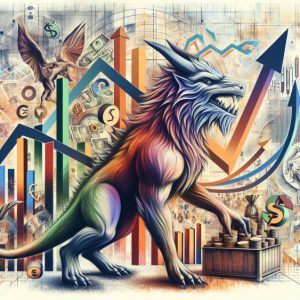Feb 26, 2024
Defying the Crowd: Contrarianism Unleashing Market Triumph
Contrarian investors are the mavericks of the financial world, often taking a path that diverges sharply from the crowd. This investment strategy is predicated on the belief that the majority can be wrong and that the market’s emotional reactions to news and events can lead to mispriced assets. Contrarians operate on the principle that fear and greed drive markets to extremes, and by identifying these extremes, they can position themselves to profit when the inevitable correction occurs.
The essence of contrarianism lies in its challenge to conventional market behaviour. When the market is bullish, with investors clamouring to buy, contrarians are meticulously analyzing for signs of overvaluation and preparing to sell. Conversely, in the depths of a bear market, when the crowd is selling in a panic, a contrarian often calmly assesses opportunities to buy undervalued assets.
This approach requires a unique blend of psychological fortitude and analytical insight. Contrarian investors must not only have the insight to recognize when the market sentiment has strayed from reality, but they also need the courage to act on their convictions, even when it means standing alone. They must be willing to endure the discomfort of going against the tide and the patience to wait for their contrarian views to align with market corrections.
Contrarianism is not just about being different for the sake of it; it’s about being rational in the face of market irrationality. It’s about having a disciplined investment approach that seeks to exploit the market inefficiencies created by the herd mentality. By going against the crowd at the right moments, contrarian investors aim to achieve superior returns, understanding that the market’s pendulum between optimism and pessimism can swing to extremes.
Harmony and Discord: Unveiling Mass Psychology in Contrarianism
Mass psychology is a powerful force in the financial markets, often driving investors to act in unison, creating a herd mentality that can lead to significant market movements. Contrarian investors, who operate by going against the prevailing market sentiment, rely on understanding these psychological dynamics to identify investment opportunities.
The Harmony of the Herd
The harmony in financial markets often reflects the collective sentiment, where investors move together, influenced by similar information and emotional responses. This can lead to a sense of security, as being part of the herd feels safer, and there is comfort in numbers. For example, during the dot-com boom of the late 1990s, investors were overwhelmingly optimistic about technology stocks, leading to a rapid price escalation. The collective belief in the internet’s transformative power drove the market to new heights, creating a harmonious ascent in stock valuations.
The Discord of Divergence
However, this harmony can quickly become discord when the market sentiment reaches an extreme. Contrarian investors seek to capitalize on these moments of discord by identifying when the market’s emotions have become detached from economic fundamentals. They look for excessive optimism or pessimism, indicating an asset is overvalued or undervalued. For instance, during the financial crisis of 2007-2008, contrarians might have recognized the unsustainable levels of leverage and speculation in the housing market, which most market participants ignored until the bubble burst.
Contrarianism Real-life Examples in Action
The Financial Crisis Astute contrarians who observed the mass psychology of over-leverage and risk-taking prelude to the 2007-2008 financial crisis could have profited by shorting the market or investing in safe-haven assets before the crash.
Commodity Cycles: In commodities, such as oil, contrarians might look for periods when the market sentiment has pushed prices to unsustainable lows or highs, diverging from the commodity’s supply and demand fundamentals.
Currency Fluctuations: In the forex market, extreme bullishness or bearishness on a currency can signal a potential reversal, where contrarians might trade against the prevailing trend.
The Subtle Art of Contrarianism
Contrarian investing is not just about going against the grain; it’s about careful analysis and timing. Contrarians must be patient and wait for the market to recognize the value they have seen in an undervalued asset or the risk in an overvalued one. They must also have the fortitude to endure potential losses or underperformance in the short term while waiting for their thesis to play out.
The Role of Mass Psychology
Understanding mass psychology is crucial for contrarians. It involves continuous analysis and observation of market dynamics, sentiment changes, and behaviour assessment. By studying the masses’ emotional drivers and behavioural patterns, contrarians can make informed, bold moves backed by research and data rather than simply following the crowd.
In conclusion, the interplay of harmony and discord in the markets, driven by mass psychology, creates a landscape ripe for contrarian strategies. By recognizing the psychological extremes and divergences from fundamental values, contrarian investors can navigate the markets in a way that often leads to substantial rewards, albeit with its risks and challenges.
Identifying Market Extremes: Fear and Greed
Fear and greed are two primary emotions that drive market sentiment and influence investment decisions. During extreme fear, investors may panic sell assets, leading to sharp price declines. Contrarian investors see these moments of fear as buying opportunities, as assets may be oversold and undervalued. Conversely, periods of greed can result in asset bubbles, where prices become detached from their intrinsic value. Contrarians look for signs of irrational exuberance to identify potential shorting opportunities.
Investors following the principles of contrarianism often adhere to the principle of “buying when there’s blood in the streets.” This phrase, attributed to Baron Rothschild, emphasizes purchasing assets when they are deeply discounted due to widespread pessimism. Contrarians believe market sentiment tends to overshoot during periods of panic or euphoria, presenting opportunities for savvy investors to enter or exit positions at favourable prices.
The Psychology of Market Reversals: Behavioral Biases
Behavioural biases are crucial in driving market sentiment and influencing investor decisions. Cognitive biases such as confirmation bias, anchoring bias, and herd mentality can lead to irrational decision-making and market inefficiencies. Contrarian investors leverage their understanding of these biases to identify opportunities where assets may be mispriced due to emotional reactions rather than rational analysis.
Contrarian investors use various tools and indicators to gauge market sentiment and identify potential turning points in asset prices. Sentiment indicators such as the put/call ratio, VIX volatility index, and surveys of investor sentiment provide valuable insights into prevailing market attitudes. By monitoring these indicators, contrarians can assess whether sentiment has reached extreme levels that may signal a reversal in asset prices.
The Role of News and Media in Shaping Market Sentiment
News media plays a significant role in shaping investor perceptions and influencing market sentiment. Positive or negative news coverage can impact investors’ perception of certain assets, leading to herd behaviour and momentum trading. Contrarian investors pay attention to media narratives but remain sceptical of consensus views, recognizing that media-driven narratives can create mispricings that present opportunities for profitable trades.
Contrarian investing requires psychological resilience and a solid mindset to withstand criticism and doubt from others. Successful contrarians have confidence in their analysis and convictions, allowing them to stay disciplined during periods of uncertainty or volatility. Developing emotional intelligence and mental fortitude is essential for contrarian investors to navigate turbulent markets and stick to their investment thesis.
Contrarianism in motion: Famous Contrarian Investors
Contrarianism is a fascinating investment philosophy that often goes against conventional market wisdom. The market’s emotional tides do not sway investors who adopt this strategy; instead, they seek to capitalize on the overreactions of others. By understanding and acting on the principles of contrarianism, some investors have made a name for themselves, not just for their wealth but for their bold and counterintuitive market moves.
Warren Buffett: The Oracle of Omaha
Warren Buffett, the CEO of Berkshire Hathaway, is perhaps the most celebrated contrarian investor. His approach often involves buying undervalued companies during market pessimism and holding onto them long-term. Buffett’s famous adage, “Be fearful when others are greedy, and greedy when others are fearful,” encapsulates the essence of contrarianism. His success is in choosing the right stocks and resisting the herd mentality that can lead to market bubbles and crashes.
Bill Ackman: Betting Big and Differently
Bill Ackman is another investor known for his contrarian bets. His investment in Valeant Pharmaceuticals and his notorious short position in Herbalife showcase his willingness to take substantial risks against prevailing market sentiments. Ackman’s strategies often involve deep research and a firm conviction in his analysis, allowing him to take positions many other investors might shy away from.
Keith Gill: The GameStop Saga
Keith Gill, known by his online alias ‘Roaring Kitty,’ became a household name during the GameStop trading frenzy. As a contrarian/value investor, Gill took a bullish position in GameStop, a company seen mainly as struggling and on the verge of decline. His position, which he shared through educational YouTube videos, paid off spectacularly as retail investors rallied against short-sellers, driving the stock to unprecedented highs.
Contrarianism is not without risks and requires a temperament to handle the stress of going against the market. It’s a strategy that demands discipline, research, and an unwavering belief in one’s convictions. The famous contrarian investors mentioned above are a testament to the potential success of this approach. Still, they highlight the commitment and expertise required to execute it effectively.
In the investing world, contrarianism is a reminder that sometimes, the most rewarding path is the one less travelled. It’s a strategy that has been employed by some of the most successful investors in history, and it continues to be a compelling approach for those looking to make their mark in the markets.
Market Cycles: Timing Reversals with Mass Psychology
Mass psychology is a potent force that shapes the ebbs and flows of market cycles. The financial markets are often gripped by collective moods ranging from extreme optimism to deep pessimism. During times of euphoria, when prices skyrocket, and the investing public is overly buoyant, the markets are ripe for a reversal. Conversely, periods of widespread fear and panic selling may present the perfect contrarian opportunities as assets become undervalued.
Contrarianism is about understanding and capitalizing on these psychological extremes. It involves a disciplined approach to analyzing the market’s emotional state and gauging the potential for reversals. By studying historical trends and recognizing the repeatable patterns of investor behaviour, contrarian investors can better time their entry and exit points.
Amid a market upswing, contrarians are often cautious when retail investors are piling into a trending asset. They are wary of the ‘irrational exuberance’ that can inflate asset bubbles. They know such conditions can lead to a dramatic correction or even a crash. They may take profits or even initiate short positions during these times, expecting the cycle to turn.
Similarly, when fear and negativity permeate the market in a downturn, contrarians look for signs of capitulation—a point where selling pressure exhausts itself, and the asset is undervalued. At these troughs of the market cycle, contrarians might accumulate positions, betting on recovery as sentiment eventually shifts.
The key for contrarian investors is not merely to go against the tide but to make calculated decisions based on a deep understanding of mass psychology and market indicators. This strategic approach to contrarianism requires patience, resilience, and the fortitude to withstand the pressure of going against the consensus. By mastering the art of timing the market’s psychological cycles, contrarian investors strive to outperform the average market returns, taking advantage of the pendulum swing between greed and fear.
The Evolution of Contrarian Strategies: Adapting to Changing Markets
Contrarian strategies have evolved with advancements in technology and changes in market dynamics. Algorithmic trading has introduced new challenges for contrarian investors by accelerating market movements and reducing reaction times. However, technological tools also provide opportunities for contrarians to analyze vast amounts of data quickly and identify patterns that may signal shifts in market sentiment.
Developing a deep understanding of behavioural biases, using sentiment indicators effectively, maintaining psychological resilience, studying case studies of successful contrarian investors, analyzing market cycles through a psychological lens, and adapting strategies to changing markets—all contribute to mastering the art of contrarian investing within mass psychology.
In conclusion, the relationship between contrarian investing and mass psychology is complex yet essential for understanding how psychological factors influence investment decisions and market behaviour. Contrarian investors leverage their understanding of mass psychology to identify opportunities where assets may be mispriced due to emotional reactions rather than rational analysis. By going against the crowd and capitalizing on market sentiment extremes driven by fear and greed, contrarians aim to profit from inefficiencies created by herd behaviour.
Delve into Captivating Chronicle

Technical Analysis of Stocks and Commodities: Unveiling Insights

Why Is the US Education System So bad: Rubbish In, Rubbish Out Phenomenon

Investor Sentiment in the Stock Market Journal of Economic Perspectives

Mass Psychology of Fascism: Unmasking Bombastic News

Identifying Trends and Buying with Equal Weighted S&P 500 ETF

Real Doppelgangers: The Risks in the Age of AI

The Intelligent REIT Investor: How to Build Wealth with Real Estate Investment Trusts

TGB Stock Forecast: Rising or Sinking

Stock Market Crash Date: If Only The Experts Knew When

Reasons Why AI Is Bad: The Dark Truth?

The Inflationary Beast: Understanding What Inflation is and What Causes It

Carnosine Benefits: An Antioxidant for Health, Longevity, and Disease Prevention

Psychology of Cursing: Why Do People Curse So Much?

Spy 200-Day Moving Average: Covert Financial Indicator Unveiled

Black Monday Crash of 1987: Turning Crisis into Opportunity



